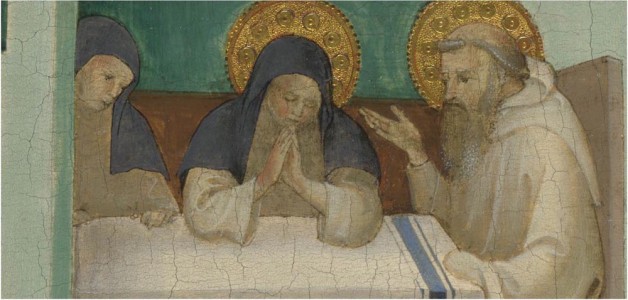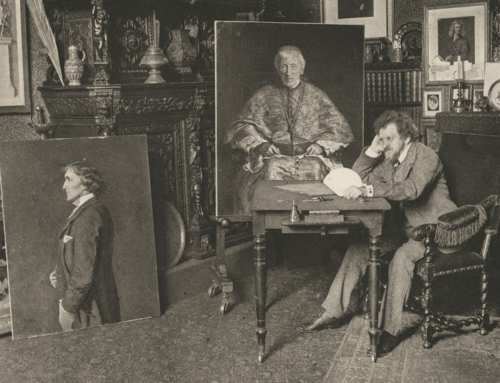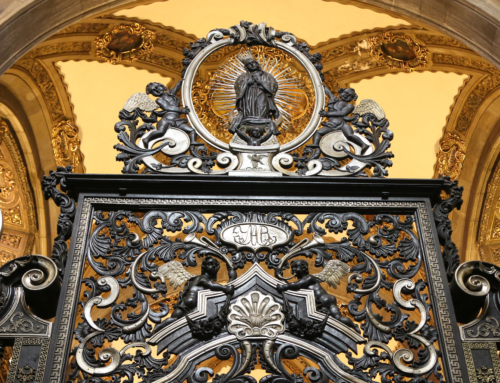In Book Two of his work, The Dialogues, Saint Gregory the Great recounts the life of Saint Benedict in great detail, following his growth from boyhood to death. Gregory presents Benedict as a man who has truly fled the world and attached himself wholly to God, according to the monastic ideal. Similar to Saint Anthony, he spent time in the desert, and emerged a champion of the spiritual life, working miracles and scattering the spiritual enemies of the Church through the power of his intercession. It seemed that there was almost nothing that Benedict could not obtain through prayer; all things needed are given him by God.
Gregory reminds his reader, however, that even saints do not always receive everything they ask for. He recalls the example of Saint Paul, who, despite his repeated prayers for relief, was left with a thorn in the flesh, that he might know Christ’s power in the weakness of humility and suffering. In a similar way, Gregory assures us that Saint Benedict’s holiness of life did not guarantee that his prayers would always be answered in the manner that he chose. To illustrate this, he recounts the well-known story of Benedict’s last encounter with his sister, Saint Scholastica, whose feast we celebrate today.
Scholastica was the abbess of a neighboring monastery, and the two met annually, spending the day in spiritual conversation. When they met for the last time before her death, Scholastica begged that Benedict stay and continue speaking with her of the things of God. But Benedict refused and, in keeping with the monastic rule, insisted that he would not sleep outside his cloister. Scholastica bowed her head, clasping her hands on the table between them, and prayed to God with tears. When she raised her head again there was a peal of thunder, and such a downpour of rain that Benedict could not set foot outside the house. At first Benedict was upset with her, questioning the merits of her action. But Scholastica simply replied that God had listened to her when he would not.
Saint Benedict was not wrong in his original intention: he desired a holy thing in attempting to keep his religious rule. But through Scholastica’s intercession, Benedict was shown a higher good. Saint Gregory, for his part, is not surprised that the prayers of a woman were more effective on this occasion. Comparing Scholastica to the woman who anointed the feet of Christ with her tears, he remarks that, because God is love, “she who loved more…accomplished more” (cf. Luke 7:43).
Gregory tells us that Benedict “encountered a miracle wrought by God at the heartfelt prayer of a woman.” Miracles are of their nature signs to others. Fittingly, then, the one who worked miracles for others by the power of prayer was made witness to the power of God’s love at work in the prayer of another. Scholastica’s love for God calls down a shower of rain, forcing Benedict to remain with her, conversing of the highest goods all through the night. The image of rain also appears in the writings of Saint Theresa of Avila, where it is used to describe the highest form of prayer. God pours down grace like rain upon the soul who loses herself completely in Him, immersing herself in God like a river emptying into the sea. And so when Scholastica turned to God in prayer, Benedict was trapped, as it were, by the holiness of another.
Saint Scholastica is the patroness of Benedictine nuns, and so it is appropriate that, on her feast day, we recall the importance of consecrated women in the Church. For Saint Edith Stein, the special identity of the consecrated woman is fully expressed only in spousal love. Because Christ was incarnate as the son of man, Stein thinks it appropriate that men function as the official representatives of Christ in this world, the priesthood and its various roles within the Church being rightly reserved to men. When Stein speaks of the spiritual dimension of woman, however, she draws our attention to the Blessed Virgin Mary, who was called to a more intimate union with Christ than any other person. For Stein, it is Mary’s “yes” to Christ that established the way of spousal union, in which a woman gives herself fully to Christ alone. First accepted by the Blessed Virgin, the grace of betrothal now opens to others a special role in the Church in the order of love.
Saint Gregory depicts Benedict as a man whose prayer was powerful, especially against the forces of evil; to this day, he is revered as a protector against the darker powers. But Scholastica reveals another side of the power of God. As a consecrated woman she follows the example of the Blessed Mother, who, like the bride in the Canticle, has found the inner wine cellar and drinks deeply of the Beloved, raising her eyes to his with a request. At Cana, Mary’s plea was not only a petition to divine power, but a personal appeal made by a mother to the heart of her son.
As a mother, Mary speaks to Christ in both his humanity and his divinity, and inasmuch as we are members of her son’s body, she speaks to us as well. Her request not only rises to God on our behalf—it draws from us the response of love. In a similar way, Scholastica’s desire, which flows from her espousal to Christ, appeals to both God and men. For this reason Saint Edith Stein is not content to say only that consecrated women are powerful intercessors; for us, they are also emissaries of God’s love, “proclaimers of His will to kings and popes, and forerunners of His kingdom in the hearts of men.”
Since the sixth century, generations of women have been inspired to follow the way of life initiated by Saint Scholastica, giving their lives to God, and to God alone. More than the founder of a religious movement, Scholastica’s place in the Church is not superfluous, or confined to a single historical period. Patterned on the Virgin Mary, her vocation stands at the centre of God’s redemptive plan, as love at the heart of the Church. May she always intercede for us, directing our attention to the love of God above all things.
✠
Banner Image: Lorenzo Monaco, St. Scholastica Prays to Detain St. Benedict, Detail from Incidents in the Life of St. Benedict
Text Image: Umbrian School, Miracle of the Rain, Fresco from the Monastery of San Benedetto, Subiaco







